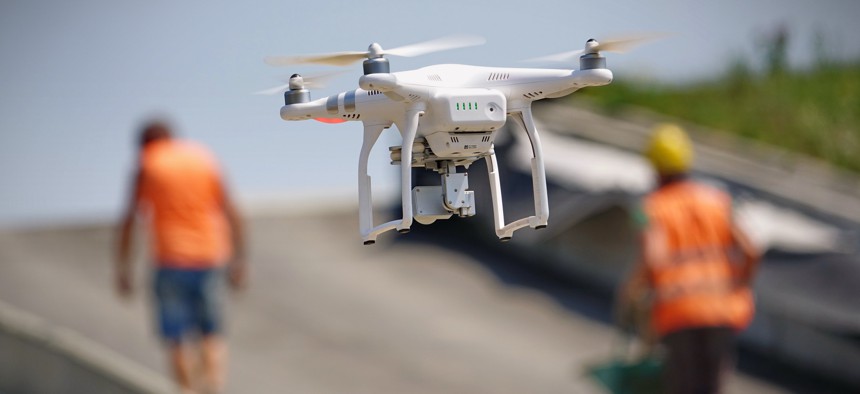Drones Can Fix Problems on the Ground

A flying drone armed with camera MikeDotta / Shutterstock.com
COMMENTARY | Expediting adoption will save lives—and possibly our failing national infrastructure.
With more than 1 million registered drones nationwide, the United States is pioneering the next generation of aviation. Beyond just recreational and retail use though, drones can play a unique role as the bridge to the future of our nation’s infrastructure—but only if our policymakers will allow them to takeoff.
It is no secret that our nation’s infrastructure has been falling apart for decades. The American Civil Corps of Engineers gave the United States’ infrastructure a D+ in its most recent report card, largely due to the poor state of our roads, bridges and highways. And without urgent attention, continuing to allow our infrastructure to fall into dereliction could cost the country $3.9 billion and result in 2.5 million jobs lost.
The use of unmanned aerial drones could provide a path forward to fixing some of our crumbling infrastructure. While drones have seen surging popularity among hobbyists, they have also attracted the attention of local lawmakers. They have great potential to be deployed in hazardous operations that are unsafe or even impossible for manned crews to handle. In fact, drone use saw an 82 percent increase by public safety agencies from 2016 to 2017.
However, the benefits don’t end with first responders. Innovative local government agencies are deploying drones to help carry out infrastructure projects more safely and efficiently than manned crews can. For example, the Spokane Public Works Department recently announced it will be allowing drones to inspect infrastructure, monitor construction and do landscape analysis. These types of initiatives can significantly reduce risks and even save lives by keeping workers out of harm’s way.
Beyond small unmanned aerial drones, cargo drones are also contributing to improving infrastructure nationwide. These larger drones are capable of carrying 500 pounds of freight as far as 300 miles, which could help reduce reliance on heavy trucks that strain roadways. With fewer cargo vehicles on our roads, bridges and highways, we can look forward to a future with a more durable and flexible infrastructure.
While these opportunities are exciting, realizing the potential of drones to help repair our infrastructure requires harmonizing federal regulations with state and local rules governing the use of drones. It is easy to imagine a scenario where drones could play a vital role fixing a bridge or tunnel that connects two adjacent states or municipalities. Without clear federal guidelines, conflicting regulations could prevent agencies from using drones to provide critical services.
And while the Federal Aviation Administration (FAA) has already proven to be forward-thinking on the potential of drones, it has been slow to translate this into clear regulatory guidelines. The FAA announced in May that it would be awarding grants to 10 cities as part of its Integration Pilot Program. The pilot program is supposed to help the FAA craft this new regulatory framework. Waiting for those regulations is an industry that is estimated to generate $82 billion and could create 100,000 jobs by 2025. While the pilot is a welcome step, more meaningful action is necessary to unleash the potential of drones to take on infrastructure projects nationwide that have been ignored for decades.
Lawmakers need to come together and pass legislation that would encourage drone use to benefit the public sector rather than allowing them to get tangled in a complex web of red tape. That includes the recently announced bipartisan efforts to increase funding for safety research and help integrate drones into the national airspace. This would be a significant step toward streamlining the use of drones for supporting our infrastructure and emergency relief efforts across the country.
Without such leadership, the future of drone use in the U.S. to improve the nation’s infrastructure and a variety of challenges facing our communities will remain grounded.
Joe Rinzel is a spokesperson for Americans for a Modern Economy, a consumer advocacy group focused on modernizing antiquated regulations and laws governing the U.S. economy.
NEXT STORY: Army wants to improve drone awareness





